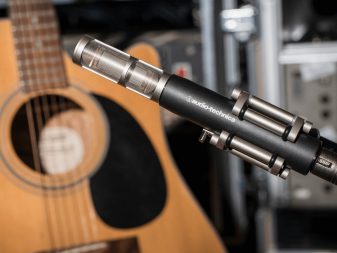 The complex and wonderful tone that comes out of the acoustic guitar is one of the most recognizable sounds in music. Hits like “Wonderwall” and “Dust in the Wind” really cemented that beautiful ringing timbre into our ears and hearts. If you are a guitarist yourself, you might wonder how to capture all that goodness to share with your friends and family, or simply to record song ideas. This guide will explain the most common approaches and give a few tips on optimizing your productions. If you are completely new to recording in general, make sure to read my introduction here.
The complex and wonderful tone that comes out of the acoustic guitar is one of the most recognizable sounds in music. Hits like “Wonderwall” and “Dust in the Wind” really cemented that beautiful ringing timbre into our ears and hearts. If you are a guitarist yourself, you might wonder how to capture all that goodness to share with your friends and family, or simply to record song ideas. This guide will explain the most common approaches and give a few tips on optimizing your productions. If you are completely new to recording in general, make sure to read my introduction here.
Recording acoustic guitar with microphones
Recording an acoustic guitar is usually done with the help of one or more microphones. You will minimally need a microphone, a stand, the appropriate cable (most likely with an XLR connector), and a recorder or sound card to interface with your computer. If these terms are new to you, they are discussed in the introduction I mentioned above.
Micing an acoustic guitar
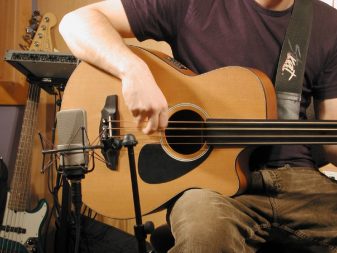 Although dynamic models (such as the SM57) are used for these purposes, sound technicians usually prefer condenser mics. Their highly detailed, airy quality lends itself very well to the nature of acoustic instruments. There seems to be a tendency to use small-diaphragm units, but larger models work very well also.
Although dynamic models (such as the SM57) are used for these purposes, sound technicians usually prefer condenser mics. Their highly detailed, airy quality lends itself very well to the nature of acoustic instruments. There seems to be a tendency to use small-diaphragm units, but larger models work very well also.
Most of the work involves finding the right spot to achieve the desired tone. It may be tempting to stick your mic right in front of the sound hole, but that’s where most of the bass resides. You’ll most likely capture a very boomy, muddy sound that’s very far away from the shimmering timbre we expect. The area where the fretboard meets the body is usually a great place to start. From there you can vary the angle and/or move down the neck.
Multiple microphones
If you have multiple microphones, you can really start to explore various combinations and techniques. One of my favourites is called the M/S (mid-side) and offers incredible width as well as depth. There are a lot of possibilities, and they require a certain amount of knowledge that is out of the scope of this article.
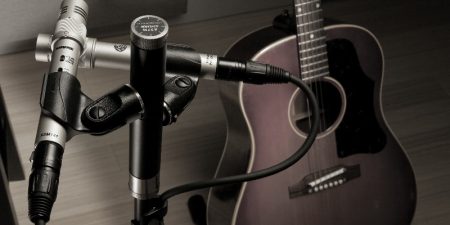
If you are going to employ multiple microphones, I will stress the importance of phase alignment. When using two microphones on the same source, you might encounter a very undesirable phasing effect. This happens when both recordings are played simultaneously but are slightly delayed from each other because of the physical distance between the source and the mic. The easiest way to fix this is to flip the phase (usually a DAW’s stock gain plugin has this possibility). I would much rather use a dedicated phase plugin to adjust the phase precisely and match it to the other track.
Recording acoustic guitar directly
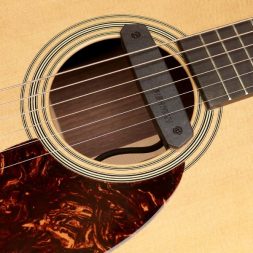 The easiest way to record an acoustic guitar is by using a built-in or temporary pickup system. A lot of instruments come with a pickup preinstalled, but if you don’t have one, you can either get one installed by a professional or play with a temporary soundhole model. All you’ll need is to plug right in to your audio interface. If you don’t have a DI box, I recommend using a short cable and an HI-Z input to match the impedance of your instrument. If you use a regular input, the tone will be altered due to the electric load applied.
The easiest way to record an acoustic guitar is by using a built-in or temporary pickup system. A lot of instruments come with a pickup preinstalled, but if you don’t have one, you can either get one installed by a professional or play with a temporary soundhole model. All you’ll need is to plug right in to your audio interface. If you don’t have a DI box, I recommend using a short cable and an HI-Z input to match the impedance of your instrument. If you use a regular input, the tone will be altered due to the electric load applied.
This type of recording produces very specific results and might not be for everyone. In a live context, this is often used for efficiency and predictability. For a studio quality, it can be underwhelming, especially for some more intricate and delicate parts, such as arpeggios or melodies. That being said, it’s still a simple, quick way of getting your ideas down, and nothing stops you from rerecording them down the line.
Additional considerations
If your aim is to get the best sounding acoustic guitar recording possible, you need to make sure that it is set up well. Nature exerts several forces on the various parts of the instrument. This can offset intonation and string height, for example. If your tuning is off, nothing will sound congruous and harmonious. Low string height can produce all kinds of buzzes and rattles that will distract the listener. Inversely, high action can make the guitar unplayable. It also affects the tone, reducing the amount of zing that is part of the timbre we recognize. Acoustic instruments can be finicky; if you are unsure how to address the problems you are having, it’s best to bring it to a professional.
Different picks
It’s a good idea to explore various picks and strings. These greatly impact the tone of the instrument, especially in the context of a recording. Picks also come in different shapes and thicknesses. Thin models are somewhat popular for strumming, as they provide a pleasant shimmer. Thick ones offer an immediate, punchy attack that I like for single note lines and riffs. Medium options are a nice balance between the two, providing more stiffness for articulated melodies than a thin one.
Various strings
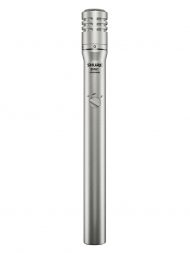 Strings are made of various alloys nowadays, and it’s a good idea to explore their tonal possibilities. Phosphor bronze is the most common alloy that gives a balanced tone. Bronze is brighter and can be useful for strummed parts in the background of a song. There are several manufacturers that offer coated strings in different thicknesses. These are hit or miss for many guitarists, but they are worth investigating. They greatly extend the lifespan of the strings and might interest players that spend a lot of time recording and playing. You usually have the choice between two types that vary the number of layers of coating applied. The thin one is a good place to start.
Strings are made of various alloys nowadays, and it’s a good idea to explore their tonal possibilities. Phosphor bronze is the most common alloy that gives a balanced tone. Bronze is brighter and can be useful for strummed parts in the background of a song. There are several manufacturers that offer coated strings in different thicknesses. These are hit or miss for many guitarists, but they are worth investigating. They greatly extend the lifespan of the strings and might interest players that spend a lot of time recording and playing. You usually have the choice between two types that vary the number of layers of coating applied. The thin one is a good place to start.
Taping acoustic guitar takes a certain amount of trial and error. The more you do it, the better you will understand the interplay between each parameter. An optimal way to work on this is to record the same part, varying only one parameter at a time. This could be a slightly different mic position, or even a new set of strings. You can then listen to the results and analyze how your change affected the result. I like to see recording as an instrument itself; it requires a good amount of practice before it becomes second nature and pleasant.
Check out all the recording equipment and acoustic guitars on Best Buy’s website.



